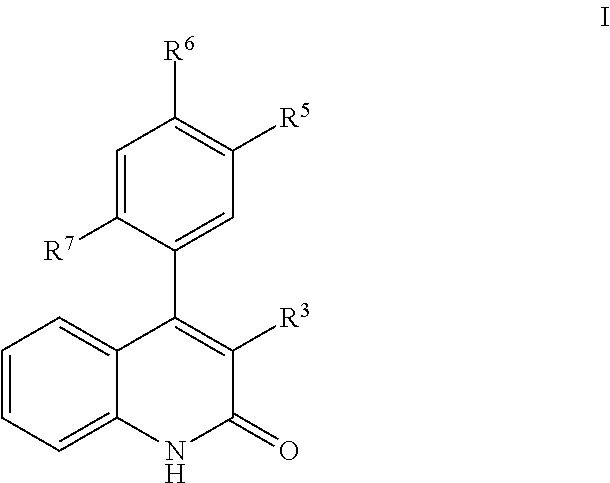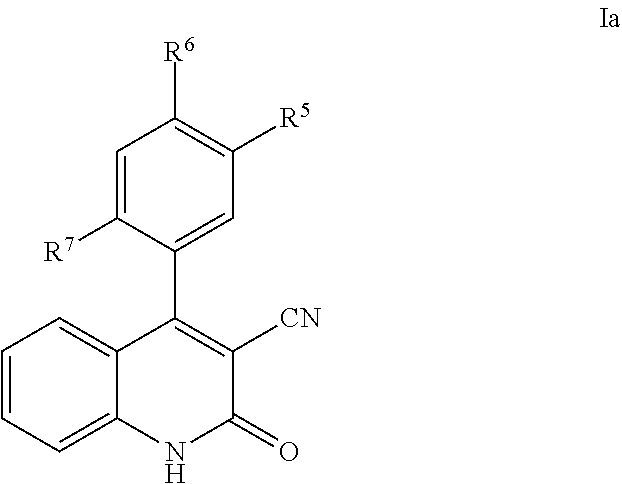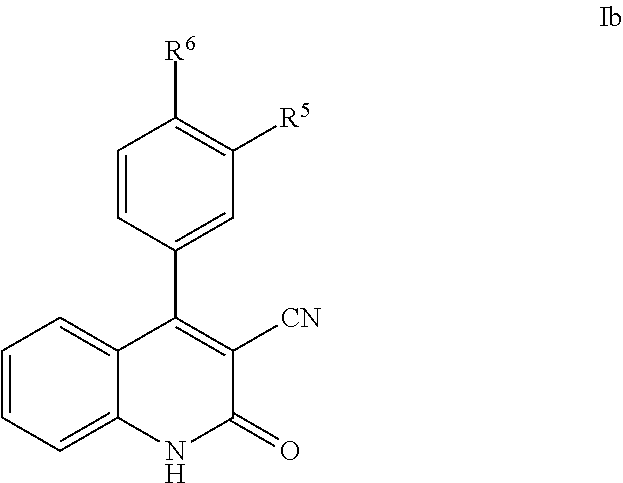Phenyl-cyanoquinolinone PDE9 inhibitors
a technology of phenylcyanoquinolinone and pde9, which is applied in the field of phenylcyanoquinolinone pde9 inhibitors, can solve the problems of high noncomplicance or discontinuation rate of medication, lack of efficacy, and dissatisfaction with therapy
- Summary
- Abstract
- Description
- Claims
- Application Information
AI Technical Summary
Benefits of technology
Problems solved by technology
Method used
Image
Examples
example 1
[0079]
4-phenyl-2-oxo-1,2-dihydroquinoline-3-carbonitrile (1-7)
2,4-dihydroxyquinoline-3-carbonitrile (1-3)
[0080]To a round bottom flask, 2H-3,1-benzoxazine-2,4(1H)-dione (Aldrich, 82 g, 503 mmol) was added and dissolved in DMF (300 ml). Ethyl cyanoacetate 1-2 (62.5 g, 533 mmol) was then added slowly and the reaction was heated to 100° C. for 5 hours, at which point it was allowed to cool and poured into H2O. The H2O layer was acidified to pH 1 with 0.5M aqueous HCl, the precipitated solid was filtered and dried to give 2,4-dihydroxy-quinoline-3-carbonitrile (1-3), HRMS (M+H)+: observed=187.1, calculated=187.1
2,4-dichloroquinoline-3-carbonitrile (1-4)
[0081]2H-3,1-benzoxazine-2,4(1H)-dione (1-3) (11.9 g, 63.8 mmol), POCl3 (44.0 g, 287 mmol) and POCl5 (26.6 g, 128 mmol) were added to a round bottomed flask and stirred at 100° C. for 2 hours. Upon completion, the reaction mixture was allowed to cool and slowly poured over ice mixture while stirring virgourly. The precipitate was filtered...
example 2
[0084]
4-(4-Ethylphenyl)-3-methylquinolin-2(1H)-one (1-14)
[0085]To a microwave vial, Pd(dppf)Cl2.DCM (11.34 mg, 0.015 mmol), cesium carbonate (76 mg, 0.232 mmol) and THF (310 μL, 0.25M) were added and the suspention was degassed for 10 minutes. Commercially available 4-chloro-3-methylquinolin-2(1H)-one (1-12, 15 mg, 0.077 mmol) was added along with 4-ethylphenylboronic acid 1-13 (23.2 mg, 0.155 mmol) and the sealed reaction vessel was heated under microwave irradiation for 30 min at 120° C. The organic solvents were removed and the crude reaction mixture was purified by reverse phase chromatography to give 4-(4-ethylphenyl)-3-methylquinolin-2(1H)-one (1-14). MS (M+H)+: observed=264.2, calculated=264.1
[0086]The following compounds were prepared according to the general procedure provided in the examples and procedures herein using known or prepared starting materials, as described in the reaction schemes and examples herein. The requisite starting materials are either prepared as desc...
PUM
 Login to View More
Login to View More Abstract
Description
Claims
Application Information
 Login to View More
Login to View More - R&D
- Intellectual Property
- Life Sciences
- Materials
- Tech Scout
- Unparalleled Data Quality
- Higher Quality Content
- 60% Fewer Hallucinations
Browse by: Latest US Patents, China's latest patents, Technical Efficacy Thesaurus, Application Domain, Technology Topic, Popular Technical Reports.
© 2025 PatSnap. All rights reserved.Legal|Privacy policy|Modern Slavery Act Transparency Statement|Sitemap|About US| Contact US: help@patsnap.com



